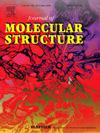将新型开架式硼钒酸铜作为环己醇转化为环己酮的有效催化剂
IF 4
2区 化学
Q2 CHEMISTRY, PHYSICAL
引用次数: 0
摘要
以 1,2-dap 为模板剂,成功制备了一种含有 V4+ 和 V5+ 两种氧化态阳离子{[Cu5(1,2-dap)10][VV2VIV10B18O54(OH)6(H2O)]}-2H3BO3-9H2O(1,2-dap:1, 2-丙烯二胺)(1) 的新型开放框架硼钒酸铜。它由五个配位阳离子[Cu(1,2-dap)2]2+和一个硼钒酸阴离子[VV2VIV10B18O54(OH)6(H2O)]10-组成,由一个{B18O30(OH)6}和两个{V6O18}亚基以及两个孤立的 H3BO3 分子和九个 H2O 分子构成。该化合物首次在开架硼钒酸盐系列中展示了五配位铜阳离子、非配位 H3BO3 分子和 1,2-dap 配体。对其紫外漫反射光谱、莫特-肖特基曲线、荧光发射、色度和二阶寿命进行了详细研究。通过荧光光谱和紫外光谱,研究了硼钒酸阴离子在 DMF 溶液中的稳定 pH 值范围(5.8-2.3)。特别是在环己醇转化为环己酮的过程中,它表现出了有效的催化活性(转化率:86.8%,选择性:97.4%)。研究还确定了该催化反应的可能催化机理。研究表明,硼钒酸盐可作为一种潜在的稳定催化剂用于环己醇的选择性氧化。本文章由计算机程序翻译,如有差异,请以英文原文为准。

Using novel open-framework copper borovanadate as an effective catalyst in the conversion of cyclohexanol to cyclohexanone
A new open-framework copper borovanadate containing two oxidation states of V4+ and V5+ cations {[Cu5(1,2-dap)10][VV2VIV10B18O54(OH)6(H2O)]}·2H3BO3·9H2O (1,2-dap: 1, 2-propylene diamine) (1) using 1,2-dap as template agent has been successfully prepared. It is composed of five coordination cations [Cu(1,2-dap)2]2+and one borovanadate anion [VV2VIV10B18O54(OH)6(H2O)]10- constructed by one {B18O30(OH)6} and two {V6O18} subunits, as well as two isolated H3BO3 molecules and nine H2O molecules. The compound exhibits for the first time penta-coordinated copper cations, uncoordinated H3BO3 molecules and 1, 2-dap ligands in the series of open-framework borovanadates. Its UV diffuse-reflectance spectrum, Mott-Schottky curve, fluorescent emission, chromaticity and second-order lifetime were investigated in detail. The stable pH range (5.8–2.3) of the borovanadate anion in DMF solution was explored by means of fluorescence and UV spectra. In particular, it showed effective catalytic activity in the conversion of cyclohexanol to cyclohexanone (conversion: 86.8 %, selectivity: 97.4 %). The possible catalytic mechanism for the catalytic reaction had been also established. The studies revealed that the borovanadate could be used as a potential stable catalyst for the selective oxidation of cyclohexanol.
求助全文
通过发布文献求助,成功后即可免费获取论文全文。
去求助
来源期刊

Journal of Molecular Structure
化学-物理化学
CiteScore
7.10
自引率
15.80%
发文量
2384
审稿时长
45 days
期刊介绍:
The Journal of Molecular Structure is dedicated to the publication of full-length articles and review papers, providing important new structural information on all types of chemical species including:
• Stable and unstable molecules in all types of environments (vapour, molecular beam, liquid, solution, liquid crystal, solid state, matrix-isolated, surface-absorbed etc.)
• Chemical intermediates
• Molecules in excited states
• Biological molecules
• Polymers.
The methods used may include any combination of spectroscopic and non-spectroscopic techniques, for example:
• Infrared spectroscopy (mid, far, near)
• Raman spectroscopy and non-linear Raman methods (CARS, etc.)
• Electronic absorption spectroscopy
• Optical rotatory dispersion and circular dichroism
• Fluorescence and phosphorescence techniques
• Electron spectroscopies (PES, XPS), EXAFS, etc.
• Microwave spectroscopy
• Electron diffraction
• NMR and ESR spectroscopies
• Mössbauer spectroscopy
• X-ray crystallography
• Charge Density Analyses
• Computational Studies (supplementing experimental methods)
We encourage publications combining theoretical and experimental approaches. The structural insights gained by the studies should be correlated with the properties, activity and/ or reactivity of the molecule under investigation and the relevance of this molecule and its implications should be discussed.
 求助内容:
求助内容: 应助结果提醒方式:
应助结果提醒方式:


